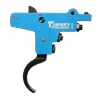theotherwaldo
Member
I've found that carefully burnishing contact surfaces will smooth and slightly reduce trigger pulls. Small engine valve stems are usually good for long strokes, Jo blocks and other hardened jig components for short strokes and small flat surfaces. Really rough surfaces can be pre-smoothed with the sides of carbide lathe bit stock, although their surfaces usually aren't smooth enough for a final finish. Surfaces test out as even harder after burnishing because of work hardening. Frequent checks with a jeweler's loupe or handheld microscope are a very good idea.
Almost no material is removed and the actual profiles are only minimally changed.
Almost no material is removed and the actual profiles are only minimally changed.





